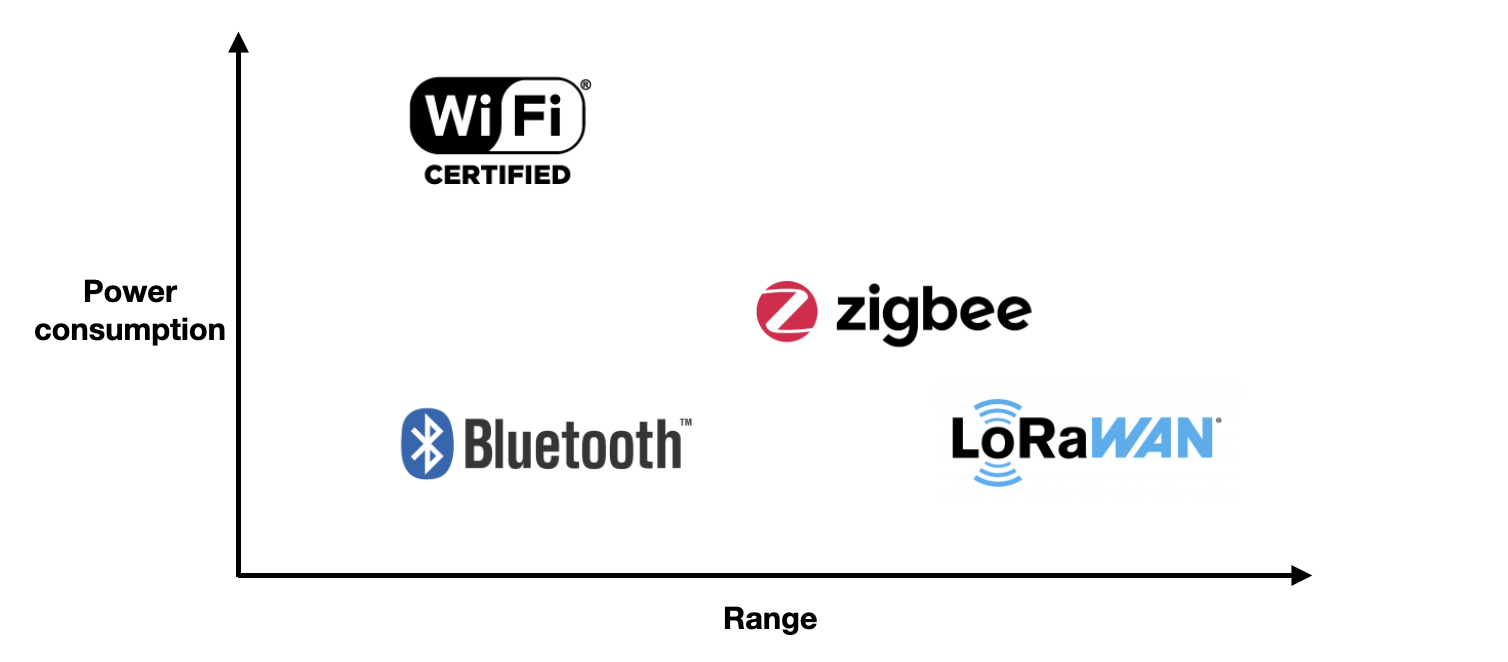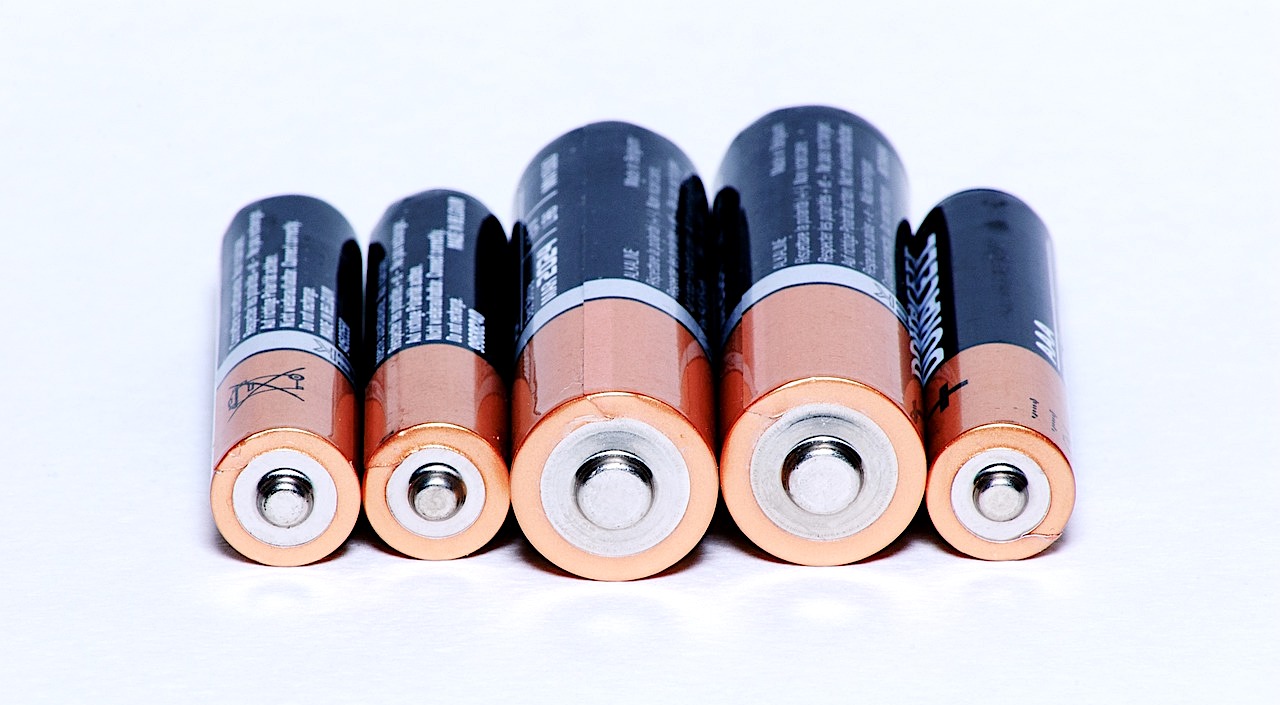Introduction
As time moves on, more and more wireless communication protocols and modulations are being developed. They all have their own area of application and some suit certain applications more than others. In this post, we want to look at different factors that influence energy consumption of some of the widely used protocols. Particularly, we will take a look at WiFi, Bluetooth, ZigBee and LoRaWAN and their different modulations such as OFDMA, GFSK, O-QPSK and CSS.
In the end, we will see how we can use this knowledge to plan and build efficient IoT and wireless networks and solutions.
Comparing Wireless Modulations
In general, a modulation describes, how a carrier signal waveform is modified by a data signal to transmit information. The data signal itself generally has a much lower frequency and for this reason, it cannot be transmitted easily. Instead, a higher frequency is used as the carrier, and the data signal “modulates” the information onto the carrier. Modulation also allows to transmit data in parallel in many different frequencies, which increases the throughput.
There are numerous modulations out there, but in our today’s IoT systems, we will mostly find the following ones:
- Some form of Frequency Shift Keying (FSK): Transmits information by changing the frequency of a carrier signal. It works like this: Imagine you have two different tones: one high-pitched (= high frequency) and one low-pitched (= low frequency). These tones represent two binary symbols, typically 0 and 1. When you want to send a 0, you transmit the high-pitched tone, and when you want to send a 1, you transmit the low-pitched tone. The receiving end detects and decodes the transmitted signal by listening to the frequency changes. When it hears the high-pitched tone, it interprets it as a 0, and when it hears the low-pitched tone, it interprets it as a 1. This way, digital data can be transmitted through the changes in the carrier signal’s frequency, making it a simple and effective method for communication.
- Some form of Phase Shift Keying (PSK): Transmits data by changing the phase of a carrier signal. It works like this: Imagine you and your friend are standing a short distance apart in a dark room, and you both have flashlights. You want to communicate with your friend using binary symbols, 0 and 1, by turning your flashlight on and off.
To use PSK, you agree on two positions for the flashlight: one pointing directly at your friend and another pointing away from your friend. These positions represent the two binary symbols, 0 and 1. When you want to send a 0, you keep the flashlight pointing at your friend, and when you want to send a 1, you quickly turn the flashlight away from your friend.
Your friend is watching for changes in the flashlight’s direction. When they see the flashlight pointing at them, they interpret it as a 0, and when they see the flashlight turned away, they interpret it as a 1. This way, you can communicate binary data through the phase shifts of the flashlight, even though you are only using two positions (on and off). - Some form of multi-carrier modulation (e.g. OFDM): Transmits data efficiently over multiple wireless channels. It works like this: Imagine you want to send a message to your friend using a bunch of colored balls. Each colored ball represents a small piece of your message. Instead of throwing all the balls to your friend at once, you divide them into groups, and each group contains balls of different colors.
Now, you and your friend have previously agreed on a specific order for these colors. For example, red, blue, green, and yellow. You start throwing one group of balls at a time, but here’s the clever part: you throw each group in such a way that the balls of different colors arrive at your friend’s end at the same time.
At your friend’s end, they are ready to receive the balls and sort them based on the agreed color order. Since all the colors arrive simultaneously, your friend can quickly and easily sort them back into the original message.
In the same way, OFDM works with data transmission. Instead of using colored balls, it uses small bands of frequency called subcarriers. The data is divided into groups and transmitted simultaneously in such a way that they don’t interfere with each other. At the receiving end, the data is sorted and reassembled to retrieve the original information. - Chirp Spread Spectrum (CSS): Imagine you have a very powerful whistle, and you want to communicate with someone far away. You could blow the whistle loudly, but the sound might not travel very far, and it could get lost in the background noise.
Instead, you decide to use a special technique called “chirping.” Chirping means producing a series of different tones that start from a low pitch and then gradually rise to a higher pitch. This way, your whistle stands out from the background noise, and it can travel much farther.
In the same way, CSS works by encoding the data into chirps, like the different tones in the whistle example. The data from sensors or devices is converted into specific chirp sequences, and these chirps are sent over long distances using radio waves.
The advantage of using CSS in LoRaWAN is that it allows devices to communicate over extended ranges (up to several kilometers) while consuming very little power.
A look at the energy consumption
Comparing the energy consumption of the different modulations is not straightforward since it depends on different factors such as implementation, signal strength, modulation schemes, and hardware used. The general rules of thumb are:
| Modulation Technique | Energy Consumption | Explanation |
| FSK | Moderate | FSK is relatively straightforward, and its energy consumption is reasonable. It’s widely used in many applications. |
| PSK | Low to Moderate | PSK is generally more energy-efficient than FSK since it requires simpler circuitry and is less susceptible to noise. |
| OFDM | Moderate to High | OFDM is more complex and requires more computational power, which can lead to higher energy consumption. This is mainly due to the use of multiple subcarrier signals and more complex mathematical pre-processing. |
| CSS | Low to Moderate | CSS can be more energy-efficient than OFDM due to its simpler processing requirements and its suitability for low-power devices. Low Peak-to-Average Power Ratio allows for efficient power amplifier design. |
Overview of Wireless Protocols
We want to look at the following protocols, together with their modulations and channel usage. We will also see how the used modulation impacts the data rate.
- WiFi 6 (IEEE 802.11ax)
- OFDMA (Orthogonal Frequency-Division Multiple Access)
- Common applications: High speed networks
- Bluetooth and BLE
- GFSK, π/4 DQPSK, 8DPSK
- Common applications: Headphones, smart home, asset tracking
- ZigBee (IEEE 802.15.4)
- O-QPSK
- Common applications: Industrial control, smart home
- LoRaWAN
- CSS (Chirp Spread Spectrum)
- Common applications: rural areas, building automation, smart cities

Wi-Fi 6 – Energy consumption
As we know, WiFi is used for high data rate and high throughput communication. This is achieved by several factors, such as multiple antennas and thus using MIMO (multiple input multiple output), many subcarriers, using large channels (20 up to 80 MHz) and shorter duty cycles.
MIMO requires complex transmission circuits. Multiple subcarriers require complex pre-processing. Large channels (= higher bandwidth) require more transmission power since the energy is spread over a wider frequency band. To achieve the same distance, more power is needed. Furthermore, shorter duty cycles result in more frequent signal transmission requiring the transmitter to be active more often.
Of course, the network topology itself also has an impact on energy consumption. The more devices are connected and the more traffic is produced (= higher network load), the more work the access point has to do.
Bluetooth and BLE – Energy consumption
Although it operates on the same frequency as WiFi, Bluetooth needs less power to operate. As mentioned above, it uses a form of FSK or PSK and thus does not need multiple subcarrier frequencies or MIMO techniques. This already explains why it needs less energy. Of course, this also shows why Bluetooth cannot reach the high data rates as WiFi does.
Also, Bluetooth does Frequency Hopping, where it rapidly switches between different frequencies in the 2.4 GHz band to avoid interference and maintain a reliable connection. This hopping mechanism allows Bluetooth to cope with interference while consuming minimal energy.
Bluetooth devices also support various power management profiles, allowing them to adapt their power consumption based on the user’s needs and network conditions.
When adding the Low Energy protocol (BLE), this improves energy consumption since BLE uses short data packets for data transfer. This reduces the time the radio transmitter needs to be active, leading to lower power consumption during communication. Also, BLE devices often use a low duty cycle, spending most of their time in sleep or low-power modes and only briefly waking up to transmit or receive data. This low duty cycle helps conserve energy and extend battery life.
Zigbee – Energy consumption
As mentioned before, ZigBee uses O-QPSK, a form of PSK. It also operates in the 2.4 GHz range. Zigbee uses small and efficient data packets for communication, reducing the time the radio transmitter needs to be active. This shortens the transmission time and results in lower overall energy consumption. The protocol stack is designed to be lightweight and efficient and specific profiles such as the Reduced Function Device (RFD) need less power than the coordinator, for example. As with BLE, devices often employ a low duty cycle, meaning they spend most of their time in low-power states and only briefly wake up to transmit or receive data.
LoRaWAN – Energy consumption
LoRaWAN is well-known for its long device battery life of up to multiple years (sometimes even up to 10 years). This is mostly achieved by low duty cycles. LoRaWAN devices typically operate with very low duty cycles of several hours or days, and then they only briefly wake up to transmit collected data. The radio transmitter is only powered on a fractional period of time.
Also, devices transmit their data directly to the gateway, avoiding the need for complex routing protocols that would require more energy. LoRaWAN supports Adaptive Data Rate, which optimizes the data rate and transmit power of devices based on the signal conditions. Devices closer to the gateway can use higher data rates, while devices farther away use lower data rates, thus conserving energy.
And, most importantly, due to the CSS modulation, LoRaWAN achieves a strong link budget, which means it can maintain communication even in challenging environments with weak signals.
Energy Optimization Techniques
When looking back at the explanations above, we can see that there are some common techniques used in wireless communication to optimize energy use:
- Duty cycling: By deep-sleeping most of the time and only waking up and transmitting infrequently, devices can improve battery life. But always remember the downside of reduced data rate and throughput.
- Power management: Utilizing power-saving features, such as sleep modes, to reduce energy consumption during idle or inactive periods.
- Adaptive data rate: Optimizing data rates and transmit power based on signal conditions to minimize energy usage in varying network environments.
- Efficient modulation: Adopting energy-efficient modulation schemes like Chirp Spread Spectrum (CSS) or Direct Sequence Spread Spectrum (DSSS) that consume less power during data transmission.
Conclusion
In this post, we have looked at modern modulation schemes and their protocols: WiFi with OFDMA, Bluetooth and ZigBee with FSK and PSK, and LoRaWAN with CSS. We have seen the key features and differences of the modulation schemes and why they behave so differently when it comes to energy consumption.
Keep these points in mind when planning a wireless system for a specific use case. For instance, if you want to equip a house with smart home technology, there is usually no need to do this using WiFi. Instead, consider more low power protocols like LoRaWAN or ZigBee.
As time goes by, more devices will be rolled out and use some form of wireless connectivity. By leveraging energy optimization techniques and embracing eco-friendly practices in your system designs, we as IoT designers can contribute to sustainable development and reduce the environmental impact.

